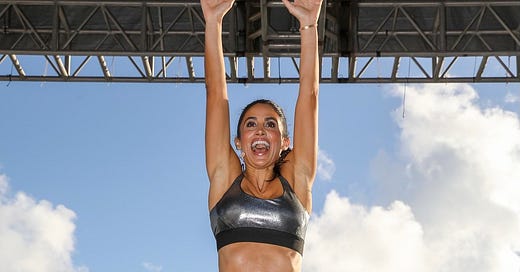Or is HIIT just too hard and it’s becoming easier to opt for more gentle ways of moving, like walking or Pilates?
On social media, there are thousands of influencers (including those who focus primarily on women’s health) who argue that high intensity exercise is not only unnecessary, but is bad. The basis of these claims is that too much cardio and HIIT exercises put the body under stress, raising cortisol levels and making it harder to lose “stubborn” fat or even gain “unwanted” weight. This oversimplification leads to an irrational fear of certain exercises and a belief in something that is not necessarily true. But if the claim is that high cortisol causes weight gain, then how do you explain individuals who are underweight but also have elevated cortisol levels?
It’s all about relationships
Let’s talk about the relationship between stress and exercise. Exercise of any kind is stress. During exercise an increase in cortisol increases our respiratory rate, helping to break down fuel and contract muscles. Cortisol regulates metabolism, immune function and blood pressure. It’s referred to as the “stress hormone” because it increases during times of stress. A momentary increase in cortisol is normal and expected during exercise.
What’s often neglected in the fitness industry are well structured exercise programs aimed to avoid overtraining or in some cases undertraining. What’s often forgotten is the distinction between acute (short-term) and chronic (long-term) stress from exercise.
Be like a Zebra
This reminds me of a book that I often open to re-read my notes in the columns. The book is called “Why Zebras Don’t Get Ulcers”.
Think about a zebra fighting for their life in the savannah woodlands. Being chased by lions is pretty stressful. Despite this increase in stress, zebras don’t get stress ulcers. And human beings, despite never being chased by lions, do. The difference is the type of stress — one being acute (short-term) and the other being what humans experience as prolonged or chronic (long-term) stress.
The argument that high intensity forms of exercise lead to increased cortisol are fundamentally misguided confusing psychological stress with physiological stress. Or referencing an exercise as HIIT but actually referring to prolonged moderate intensity exercise such as CrossFit or classes at F45 or Orange Theory that are typically 45-60 min in duration. During this extended period of time, maintaining true high intensity efforts for that duration is not feasible unless you are an extreme high performance athlete. HIIT is typically defined as training intervals at 80-100% effort from a few seconds to 4 minutes with varying rest in between. Think of HIIT as sprinting up high peaks on a bike followed by cruising down descents versus cycling through 45-60 min of mud.
Benefits of HIIT are numerous
It’s true after any exercise there is an increase in cortisol levels. But what is important to understand is that acute cortisol response from exercise is normal and decreases as the body adapts to the training stimulus overtime which helps lower stress levels. For moderate intensity exercise cortisol levels can stay elevated for up to 24 hours following a session. With high intensity exercise there is a decrease in cortisol within a couple of hours, resulting in lower cortisol over the long term.
The benefits of HIIT are numerous from losing weight, burning fat, and building muscle. HIIT can also help lower blood pressure and blood sugar while improving oxygen and blood flow. High Intensity Interval Training may also benefit brain health by improving mental health & stress levels.
Recognize the difference and take inventory
For various reasons, there seems to be an obsession lately with cortisol and the need to regulate it through supplements or less intense exercises which has only led to bold claims, especially on social media. Chronically elevated cortisol levels can cause weight gain, impaired immune function, and increased blood sugar levels. But as I have explained above there is a difference between chronically and acute. It’s important not to confuse the two types of stress. If you keep listening to the hype around cortisol that is being put out there, you may ultimately convince yourself your hormones are all out of whack.
Before you conclude that your cortisol levels are the culprit, learn to recognize the difference between chronic vs. acute stress, and take inventory of your sleep, your nutrition, your lifestyle. Worry less on what’s the right type of exercise for your hormones, and find ways to mange your stress so that it doesn’t become a chronic issue.
Here are a few ways I find helpful to manage stress:
Music
Music is effective for relaxation and stress management. Upbeat music can make you feel more optimistic while slower tempo music can quiet your mind and relax your muscles, making you feel soothed while releasing the stress of the day. I play music throughout the day in my home or in the car to keep stress at bay. Here’s my “Stress Less Summer Vibes” playlist if you’d like to have a listen:
Candles
Candles are an amazing way to relieve stress. They can create a soothing environment and promote calmness for both your body and mind when you're dealing with stress or anxiety.
Heat Therapy
A bath can do the job of a warm hug or at the least the exposure to heat can improve mental well being. Even holding a warm hand has been proven to buffer a stress response. Whether it’s a sauna, hot tub, or a warm bath, heat has a calming effect on the body and mind. It helps to relax the nervous system, reducing stress, anxiety, and promoting a sense of relaxation and well-being. Also I often like this heat wrap (click here for JJ’s favorite Heat Wrap) which offers targeted muscle relief.
Matcha
If you don’t have a warm hand to hold, a hot cup of matcha makes for a great date. And it won’t stress you out! I’ve been drinking matcha consistently since 2017 and I credit this green powerful powder in helping me to manage my stress in addition to a long list of other benefits I’ve experienced. Matcha has the power to help you feel calm and focused whilst supporting your health and metabolism at the same time. Matcha contains extremely high levels of antioxidants such as chlorophyll, caffeine, catechins, and specifically L-Theanine in regards to stress management. L-theanine improves mental focus, alleviates stress and anxiety, improves quality of sleep, helps you feel more satiated, and reduces the negative side effects of caffeine. This powerful amino acid is responsible for matcha’s sweeter note tastes which is why the quality of matcha is important. That’s why I only drink KO Matcha because it’s the absolute best! (find KO Matcha here)
GET LEANER & STRONGER
With proper recovery, nutrition and stress management your body is prepared to take on physical challenges no matter how INTENSE especially when they only last 20 min.
Now is the time to increase the intensity and accelerate into summer. The training plan I’ve methodically created is called HIIT IT STRONG BOOTCAMP. This 6 week calendar (Part 1 and Part 2) features select Job 1 & Job 1 Super Block sessions formatted to get leaner & stronger without heavy equipment or heavy dumbbells. Burn fat, build muscle & unleash your best self in only 20 min a day 5 x a week.
The quickest way to accelerate growth is NOW!







Love that you are sharing about this topic like Idalis did! You are both my faves! Keep up the good work.
Thanks for this essential breakdown of HIIT, which has been somewhat of a controversial/divisive subject in fitness, aside from burpees, hahah. In fact, I find that burpees are great for HIIT routines. Regarding the other aspects you mention, I was nodding my head in agreement throughout the post. I often have two cups of matcha (one hot and one cool) before my workout, and having a motivational playlist is also major boost for my sessions.